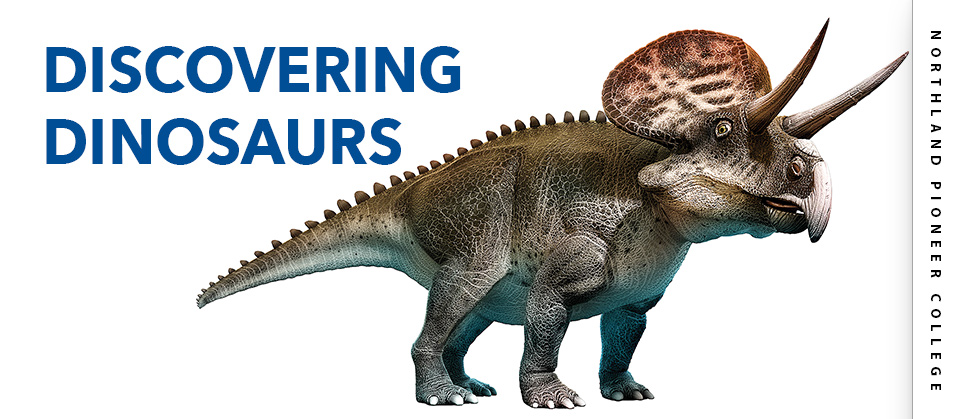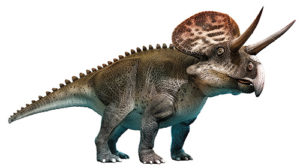 New Course Combines Paleontology, Geology and Biology
New Course Combines Paleontology, Geology and Biology
Northland Pioneer College will become the first community college in Arizona to offer an undergraduate paleontology course about dinosaurs in the fall of 2017! NPC Biology Professor Dr. David Smith and his colleague, paleontologist Doug Wolfe, will team-teach the new geology course (GLG 202, Dinosaurs) focusing on the ecology, physiology and basic scientific methods used in researching dinosaurs.
This exciting new course will transfer as a science elective into the paleontology programs at Northern Arizona University and the University of Arizona.
Learning from instructors Smith and Wolfe, whose findings have been shared at numerous international conferences, including last October’s Society of Vertebrate Paleontology (SVP) conference in Salt Lake City, students will apply biological and paleontology concepts and develop a field notebook outlining the bone structure and nervous and muscular systems of dinosaurs. Students will also study the origin and evolution of birds, the concept of extinction and basic scientific methods, including dissection of modern-day birds. Many scientists consider modern-day birds to be descendants of dinosaurs. Best of all, students will get a chance to explore various local rock formations, “right under our feet,” notes Wolfe.

The discovery of Zunicer-
atops is important because
it is the oldest species recovered from North America that was a herbivorous, beaked dinosaur known to have brow horns.
“With so much geological and paleontological diversity, it is strange that Arizona has so few active paleontologists and educational programs,” adds Wolfe. “I’m excited about NPC’s new course that will hope-fully spark additional interest in the field.”
Wolfe’s training in micropaleontology and biostratigraphy led him to the Zuni Basin along the Arizona/New Mexico border. Working as a consultant with the U.S. Geological Survey and other partners, he re-dated many of the rock formations in that region, as well as on the Little Colorado Plateau. While exploring the basin, Wolfe noticed dozens of bone fragments, weathered out by a nasty thunderstorm the previous week. “One fit neatly onto a bone sticking out of the hill,” recalls Wolfe. The site became known as the Haystack Butte Bonebed.
The scientific name given to the dis-covery was Zuniceratops christopheri, – honoring the Zuni tribe and Wolfe’s son Christopher, who was 7 years old at the time and picked up the first fragment from the horn-core. “We recovered a few hundred bones over several years from that site, mostly Zuniceratops, the oldest ‘horned’ dinosaur in North America, an early ancestor of Triceratops.”
Eventually, Wolfe realized he had bones other than from Zuniceratops that were very similar to Asian Therizinosaurs. After collecting more evidence with Utah State Paleontologist Dr. James Kirkland, the find was named Nothronychus– it was the first Therizinosaur found outside of Asia.
Dr. Smith, who specializes in vertebrate paleontology, and Wolfe have been collaborating on digital imaging of the brain-cases of both Zuniceratops and Nothronychus. An NPC professor since 2005, Smith presented his research findings on the airspaces in the brain and skull areas and the nervous and muscular systems of the Nothronychus at the October SVP conference. “Our study shows the Nothronychus was very sensitive to very low frequencies, such as those from approaching storm systems, although they probably did not emit sounds in those frequencies,” remarks Smith. Scientists, including Smith, are now starting to focus on the arm structure, with early indications that it was a possible swimmer.
Wolfe, his wife Hazel and son Christopher operate the White Mountain Dinosaur Exploration Center (WMDEC) in Springerville and routinely partner with university field teams recovering fossils in the region. WMDEC features numerous specimens and exhibits, including a photo of a three-toed track discovered by Wolfe nearly a decade ago while recording a pack of smaller carnivorous dinosaurs possibly hunting a larger plant-eater. His research on the tracks, also presented at the October SVP conference, was the subject of a January 5, 2017, USA Today article.
In addition to teaching at NPC, Smith and Wolfe are making plans to explore major dinosaur fossil sites in China, Mongolia and Russia during the summer of 2018, with their findings to be published in a future textbook
Contact an NPC academic adviser to find out how to register for this exciting new class.
– Everett Robinson
